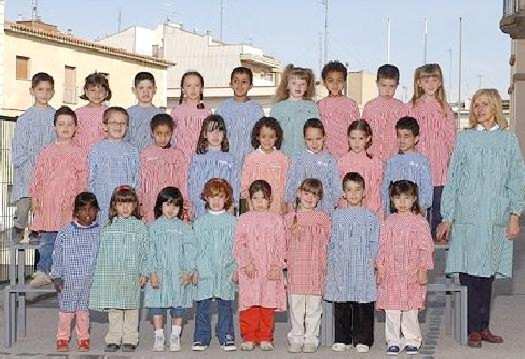
Spanish School Smocks: Color Gender Conventions

Figure 1.--The boy and girls at this Spanish school wear different colored smocks. The styleslooks similar, but the children could apparntly choose the color. Note that some boys wear pink and some girls blue. I'm not sure about the date, but it looks like the 1990s.
|
Some schools now use the same colors for boys and girls, using stylistic differences rather than colors to differentiate boys and girls. Blue for boys and pink for girls were sometimes selectd, but there were many others colors used. And as can be seen here, at some schools both boys and girls could choose the color, including blue and pink (figure 1). At other schools the children wore a variety of different colors with the same style that they choose themselves. This is especially true of Catalan schools, we are less sure about schools smocks in other regions of Spain. We are unsure how common this use of color to differentiate boys' and girls' smocks was in earlier periods or just when this convention was first adopted. Other colors are also used to differentiate boys and girls. We know that some schools have the same color smocks for all the children, but used only stylistic differences for boys' and girls' smocks. We have so little information about Spanish smocks that we cannot yet confirm that this is a common practice. Some schools used both color and stylistic differences in smocks to differentiate the smocks worn by boys and girls. The tendency to use color to differentiate boys and girls seems to be changing in Spain. A HBC reader in Spain writes, "Las batas en España y también en Cataluña tienen unos colores muy variados. Las batas de color azul son normalmente vestidos por los niños, ya que el color azul se considera más masculino. En cambio las batas de color rosa, pink, son normalmente para chicas porqué se considera más femenino. En cierta manera es un rol social que no afecta solo a las batas. No obstante, en los últimos años, se ha podido observar que las niñas y niños visten las batas de un único color. La escuela, para fomentar la igualdad entre hombre y mujeres establece que todos vistan un único modelo de bata y del mismo color." This means, "Smocks in Spain and also in Catalonia come in a large variety of colors. The blue smocks are normally for boys because the color is considerd more masculine. In contrast, pink smocks are normally for girls as the color is considered more feminine. In a certain form it is a social role that is not only used for school smocks. Even so, in recenbt years one can observe taht gils and boys dressed in the same color of school smock. Some schools to promote equality among girls and boys have begun requiring smocks of the same color and style."
HBC

Navigate the Historic Boys' Clothing Web Site:
[Introduction]
[Activities]
[Bibliographies]
[Biographies]
[Chronologies]
[Countries]
[Style Index]
[Contributions]
[Expanded Site]
[FAQs]
[Style Index]
[Satellite sites]
[Boys' Clothing Home]
Navigate the Historic Boys' Clothing Web chronological pages:
[The 1890s]
[The 1900s]
[The 1910s]
[The 1920s]
[The 1930s]
[The 1940s]
[The 1950s]
[The 1960s]
[The 1970s]
[The 1980s]
Navigate the Historic Boys' Clothing Web style pages:
[Return to the Main Spanish school smock color page]
[Return to the Main national smocks page]
[Dresses]
[Bodice dresses]
[Kilts]
[Sailor suits]
[Sailor hats]
[Ring bearer/page costumes]
[Pinafores]
[Shortalls]
Created: September 18, 2002
Last updated: May 8, 2003



